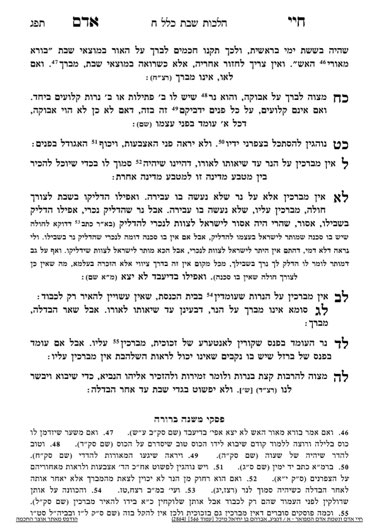BE”H, we will be starting Klal 9 on January 1st. Klal 9 is all of the basic rules of meleches Shabbos, and therefore a very important klal. Sponsorships are available for the whole klal or individual concepts or individual shiurim. Please contact Rabbi Reingold at (301)996-5910 or rabbireingold@gmail.com to sponsor
We are beginning siman 34. The Chayei Adam quotes the Gemara that one cannot make the bracha of borei meorei haeish on a pannas. There is a machlokes rishonim in understanding what is a pannas.
The Rashba understands it was a metal utensil into which a candle is placed but where it is not possible to see the shalheves, the flame. Thus, we emerge with the important halacha that one must see the shalheves of the neir before making the bracha or in order to be yotzei with another person’s bracha. Seeing the radiant light is not sufficient; one must see the actual flame. This is meakev even bedieved.
Rashi understands that the pannas was made of either transparent or translucent glass. The Biur Halacha suggests that Rashi holds the problem with the pannas is that since we are making the bracha of borei meorei haeish on the first fire of Adam Harishon, it should be exposed and not closed, just like Adam’s first fire. Thus, according to the Mishnah Berurah, one should be machmir for this opinion and should not make a bracha on a fire which is not exposed. The Piskei MIshnah Berurah (note 55) notes that the Mishnah Berurah holds one should be machmir in this regard.
If so, the question could be asked whether it is an issue for one to wear glasses while looking at the neir. Based on the Biur Halacha, that the opinion of Rashi is that the flame should remain exposed, there is no problem wearing glasses, because the flame is exposed and the cover is on the person.
Similarly, it would seem that it would be muttar to see a neir through the window. However, practically speaking, the Mishnah Berurah is machmir in this case.
We are going to discuss electric lights. It is not a question that one cannot make a bracha on flourescent or LED lights. They have nothing burning to be considered a flame. The only question applies to incandescent bulbs. There is a small metal strip inside a bulb which receives electricity. It causes friction, which creates heat to the point that the metal glows and produces light. Halachically, meal which becomes hot enough to flow is considered fire. However, since it is within a glass enclosure (the bulb), seemingly, according to the Mishnah Berurah, one should avoid using such a fire. On the other hand, other poskim hold that since the primary use of the bulb is to create fire, and the glass enclosure is necessary in order to maintain the vacuum inside, it is not an issue.
It is famously known that Rav Chaim Ozer used to make havdalah on Motzaei Shabbos on an electric bulb. He did so to stress the idea that electricity is assur on Shabbos. However, practically, one should avoid using a lightbulb if they are able to.
If one has no other choice, and they have an incandescent bulb, bedieved they are yotzei with it.
Summary
- One cannot make the bracha on neir unless they see the actual flame.
- Preferably, one should be concerned for the opinion of the Mishnah Berurah that the neir should be exposed.
- Bedieved, one is yotzei with an incandescent lightbulb.



